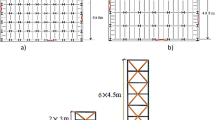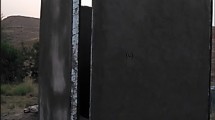Abstract
This paper presents a customised beam finite element and analysis formulation for structures in fire, where structures are modelled as skeletal frames, even for composite frames. This provides a simple and fast approach, suitable for design office analyses, with the objective of making structural fire design more accessible for consulting engineers. The methodology proposed has a generic formulation so is suitable for concrete, steel or composite structures. A single, resultant bending and axial stiffness is calculated for a generic cross-section. Stiffnesses are calculated about updated neutral axis positions, which can change during analyses. Thermal effects are applied using resultant pseudo forces. Three case studies are investigated with predicted and experimental deflections showing good correlation. Case Study 1 presents a concrete slab subjected to a standard fire, and deflections predicted by the proposed methodology are between 4.7% and 16.9% different from experimental results, comparable to an advanced modelling system. Two composite beams are considered in Case Study 2. Results for the first composite beam are almost indistinguishable from deflections predicted by a significantly more complicated 3D analysis method in the literature. The runaway failure that occurs during the second composite beam experiment is anticipated by the proposed formulation. In Case Study 3 a full composite floor slab subjected to a real fire is investigated. A novel contribution of the paper is demonstrated in that a slab experiencing tensile membrane action can be modelled using a series of beam elements. Predicted deflections are typically in the order of 12.7% different from experimental results (with both over and under predictions occurring), closer to experimental results than a contemporary full 3D analysis. The aforementioned case studies are carried out using subroutines coupled with a simple, commercially available, finite element program to demonstrate the effectiveness of the approach.












Similar content being viewed by others
Abbreviations
- A:
-
Cross-sectional area (m2)
- b:
-
Breadth of section (m)
- c:
-
Neutral axis position (m)
- e:
-
Eccentricity of applied load (m)
- E:
-
Young’s modulus (kPa)
- EA:
-
Axial stiffness (kN)
- EI:
-
Bending stiffness (kN m2)
- I:
-
Second moment of inertia (m4)
- M:
-
Moment (kN m)
- N:
-
Axial force (kN)
- y:
-
Distance from the neutral axis (m)
- ε:
-
Strain
- θ:
-
Temperature
- i:
-
Integration point number
- n:
-
Number of integration points
- tr:
-
Transient
- σ:
-
Stress
- θ:
-
Temperature
References
Buchanan AH, Abu AK (2017) Structural design for fire safety, 2nd edn. Wiley, Chichester
Walls RS (2016) A beam finite element for the analysis of structures in fire. Ph.D. Thesis, Stellenbosch University
BSI (2005) BS EN 1992-1-2:2005: Eurocode 2: design of concrete structures—part 1–2: general—structural fire design. British Standards Institute, London
BSI (2005) BS EN 1993-1-2:2005 Eurocode 3—design of steel structures, part 1.2: general rules—structural fire design. British Standards Institute, London
BSI (2005) BS EN 1994-1-2:2005: Eurocode 4: design of composite steel and concrete structures—part 1–2: general—structural fire design. British Standards Institute, London
Iding R, Bresler B, Nizamuddin Z (1977) FIRES RC II—a computer program for the fire response of structures—reinforced concrete frames (revised version). Washington DC
Bresler B (1985) Analytical prediction of structural response to fire. Fire Saf J 9:103–117
Franssen J-M (2005) SAFIR. A thermal/structural program modelling structures under fire. Eng J AISC 42:143–158
Stadler M (2012) Design of composite slab systems in case of fire using simplified finite element analyses
Burgess IW, Plank RJ, Green M, et al (2015) Vulcan. Vulcan solutions, Seattle
Gillie M, Usmani AS, Rotter JM (2001) A structural analysis of the first Cardington test. J Constr Steel Res 57:581–601. https://doi.org/10.1016/s0143-974x(01)00004-9
Jiang J, Usmani A, Li G (2014) Modelling of steel-concrete composite structures in fire using OpenSees. Adv Struct Eng 17:249–264
Jeffers AE, Sotelino ED (2009) Fiber heat transfer element for modeling the thermal response of structures in fire. J Struct Eng 135:1191–1200. https://doi.org/10.1061/(asce)st.1943-541x.0000043
Jeffers AE, Sotelino ED (2012) An efficient fiber element approach for the thermo-structural simulation of non-uniformly heated frames. Fire Saf J 51:18–26. https://doi.org/10.1016/j.firesaf.2012.02.002
Walls RS, Viljoen C, de Clercq H, Clifton GC (2017) Reliability analysis of the slab panel method (SPM) for the design of composite steel floors in severe fires. J Struct Fire Eng 8:84–103. https://doi.org/10.1108/jsfe-01-2017-0008
Guo Q, Shi K, Jia Z, Jeffers AE (2013) Probabilistic evaluation of structural fire resistance. Fire Technol 49:793–811. https://doi.org/10.1007/s10694-012-0293-6
Usmani AS, Rotter JM, Lamont S, et al (2001) Fundamental principles of structural behaviour under thermal effects. Fire Saf J 36:721–744. https://doi.org/10.1016/s0379-7112(01)00037-6
Bathe KJ (2006) Finite element procedures. K.J. Bathe, Massachusetts
Coates RC, Coutie MG, Kong FK (1990) Structural analysis, 3rd edn. CRC Press, London
Walls RS, Botha M (2016) Towards a structural fire loading code for buildings in South Africa. In: Zingoni A (ed) Insights and innovations structural engineering, mechanics and computer. Taylor & Francis, Cape Town, pp 1761–5
Bailey CG (2004) Membrane action of slab/beam composite floor systems in fire. Eng Struct 26:1691–1703. https://doi.org/10.1016/j.engstruct.2004.06.006
Clifton GC, Abu A (2014) Modifications to the Application of the SPM:2006 edition and application to C/VM2. Auckland University, Auckland
Nadjai A, Vassart O, Zhao B (2012) MACS + engineering background. Arcelor-Mittal, Luxembourg
OpenSEES (2017) Open system for earthquake engineering simulation. UC Berkeley, Berkeley
Cook RD, Malkus DS, Plesha ME, Witt RJ (2001) Concepts and applications of finite element analysis, 4th edn. Wiley, Madison
Ali F, Nadjai A, Abu-tair A (2008) Experimental and numerical study on performance of concrete slabs subjected to severe fire. In: IAFSS ninth international symposium fire safety science, pp 1255–1266
Stern-Gottfried J, Rein G (2012) Travelling fires for structural design-part I: literature review. Fire Saf J 54:96–112. https://doi.org/10.1016/j.firesaf.2012.06.011
Clifton GC (2006) R4-131:2006 design of composite steel floor systems for severe fires. HERA, Auckland
Wang W, Wang K, Engelhardt MD, Li G (2016) Behavior of steel–concrete partially composite beams subjected to fire—part 1: experimental study. Fire Technol. https://doi.org/10.1007/s10694-016-0618-y0
Wang W, Wang K, Engelhardt MD, Li G (2016) Behavior of steel–concrete partially composite beams subjected to fire—part 2: analytical study. Fire Technol. https://doi.org/10.1007/s10694-016-0624-0
SAISC (2013) Southern African steel construction hand-book “the red book.” Southern African Institute of Steel Construction, Johannesburg
Walls RS, Viljoen C, de Clercq H, Retief J (2014) A critical review on current and proposed structural fire engineering codes for steelwork in South Africa. In: S.O. Ekolu et al (ed) Construction materials structures. IOS Press, Johannesburg, pp 1134–1140
Tian Y (2014) The tensile membrane action of non-orthogonal composite slabs at elevated temperatures. University of Sheffield, Sheffield
SCI (2009) TSLAB v3.0.xls—the analysis of composite floor slabs in fire. SCI, Buckhurst
Dassault Systèmes (2016) Abaqus. Dassault Systèmes, Providence
Fib (2010) Model code 2010—first complete draft—volume 2. Federation Internationale du Beton, Lausanne
Prokon SCL (2015) Prokon frame. Prokon Software Consultants Ltd, Pretoria
Ali F, Nadjai A, Abu-Tair A (2010) Explosive spalling of normal strength concrete slabs subjected to severe fire. Mater Struct 44:943–956. https://doi.org/10.1617/s11527-010-9678-5
TNO DIANA (2016) DIANA. TNO, Delft
JCSS (2001) Probabilistic model code, 12th Draft edn. Bygning, Denmark
Wainman DE, Kirby BR (1988) Compendium of UK standard fire test data (unprotected structural steel—1). Rotherham
Benedetti A, Mangoni E (2007) Analytical prediction of composite beams response in fire situations. J Constr Steel Res 63:221–228. https://doi.org/10.1016/j.jcsr.2006.04.013
BSI (2004) BS EN 1992-1-1:2004—Eurocode 2: design of concrete structures—part 1-1: general rules and rules for buildings. British Standards Institute, London
Mensinger M, Schaumann P, Stadler M, Sothmann J (2012) Nutzung der Membran-wirkung von Verbundtrager-Decken-Systemen im Brandfall. DASt-Forschungsbericht
Al-Jabri KS, Burgess IW, Lennon T, Plank RJ (2005) Moment—rotation—temperature curves for semi-rigid joints. J Constr Steel Res 61:281–303. https://doi.org/10.1016/j.jcsr.2004.09.001
Acknowledgements
This work has been supported in part by the National Research Foundation of South Africa under a Thuthuka grant, Unique Grant No. 99304. Any opinion, finding and conclusion or recommendation expressed in this material is that of the author(s) and the NRF does not accept any liability in this regard.
Author information
Authors and Affiliations
Corresponding author
Additional information
Publisher's Note
Springer Nature remains neutral with regard to jurisdictional claims in published maps and institutional affiliations.
Rights and permissions
About this article
Cite this article
Walls, R.S., Viljoen, C. & de Clercq, H. Analysis of Structures in Fire as Simplified Skeletal Frames Using a Customised Beam Finite Element. Fire Technol 54, 1655–1682 (2018). https://doi.org/10.1007/s10694-018-0762-7
Received:
Accepted:
Published:
Issue Date:
DOI: https://doi.org/10.1007/s10694-018-0762-7




